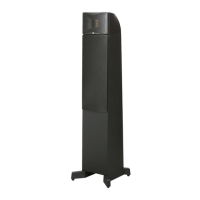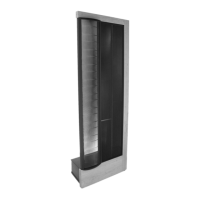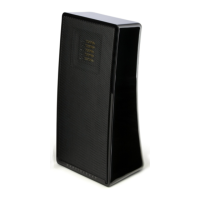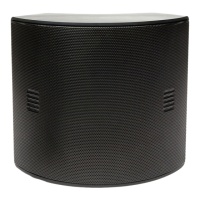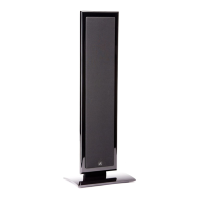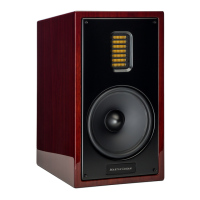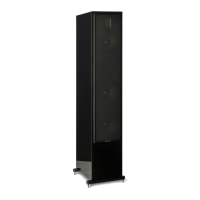Do you have a question about the MartinLogan Prodigy and is the answer not in the manual?
Steps for removing speakers from packaging and initial assembly.
Guidance on initial speaker positioning relative to listening area and walls.
Instructions for connecting AC power and audio signal cables.
The final step of turning on the system and enjoying the audio.
Detailed steps for correctly mounting the electrostatic panel assembly.
Instructions for attaching the front and rear grill cloths to the speakers.
Connecting the speakers to AC power and amplifier outputs.
Information on the initial break-in period and correct speaker wire polarity.
Advanced connection methods for improved audio performance.
How to use the bass control switch to tailor low-frequency response.
Advice on determining the optimal listening seat for best imaging and stage width.
Managing reflections from front, back, and side walls for improved clarity.
Tips for adjusting speaker position, toe-in, and other factors for optimal sound.
Using measurements to determine ideal speaker distance from walls.
How room dimensions and surfaces affect sound quality.
Defines terms like standing waves, reflections, and resonant cavities.
Ensuring speaker stability with spikes for improved bass and imaging.
How the speaker's 30-degree pattern enhances listening flexibility.
The four-foot line source design minimizes floor and ceiling interactions.
Explains point source vs. controlled wave-front dispersion.
Importance of front left, right, and center speakers in a home theater.
Guidelines for selecting and placing surround speakers and subwoofers.
How electrostatic speakers work, contrasting with traditional drivers.
The ability of a single electrostatic element to reproduce a wide frequency range.
Technology for achieving smooth horizontal sound dispersion.
Innovative system to control bass reflections for easier placement.
Details on vapor deposited film and transducer construction for durability.
How to properly clean and maintain the electrostatic panels.
Guidance on choosing suitable amplifiers and cables for MartinLogan speakers.
Information on sunlight exposure, humidity, and electrical safety.
Answers to common problems like hissing or dust attraction.
Steps to diagnose and resolve issues with no audio output or loss of high frequencies.
Solutions for muddy bass, lack of bass, or poor stereo imaging.
Identifying and fixing popping, ticking, or other unusual noises.
Details on the limited warranty coverage and registration process.
Information on obtaining service and support for your speakers.
Steps for removing speakers from packaging and initial assembly.
Guidance on initial speaker positioning relative to listening area and walls.
Instructions for connecting AC power and audio signal cables.
The final step of turning on the system and enjoying the audio.
Detailed steps for correctly mounting the electrostatic panel assembly.
Instructions for attaching the front and rear grill cloths to the speakers.
Connecting the speakers to AC power and amplifier outputs.
Information on the initial break-in period and correct speaker wire polarity.
Advanced connection methods for improved audio performance.
How to use the bass control switch to tailor low-frequency response.
Advice on determining the optimal listening seat for best imaging and stage width.
Managing reflections from front, back, and side walls for improved clarity.
Tips for adjusting speaker position, toe-in, and other factors for optimal sound.
Using measurements to determine ideal speaker distance from walls.
How room dimensions and surfaces affect sound quality.
Defines terms like standing waves, reflections, and resonant cavities.
Ensuring speaker stability with spikes for improved bass and imaging.
How the speaker's 30-degree pattern enhances listening flexibility.
The four-foot line source design minimizes floor and ceiling interactions.
Explains point source vs. controlled wave-front dispersion.
Importance of front left, right, and center speakers in a home theater.
Guidelines for selecting and placing surround speakers and subwoofers.
How electrostatic speakers work, contrasting with traditional drivers.
The ability of a single electrostatic element to reproduce a wide frequency range.
Technology for achieving smooth horizontal sound dispersion.
Innovative system to control bass reflections for easier placement.
Details on vapor deposited film and transducer construction for durability.
How to properly clean and maintain the electrostatic panels.
Guidance on choosing suitable amplifiers and cables for MartinLogan speakers.
Information on sunlight exposure, humidity, and electrical safety.
Answers to common problems like hissing or dust attraction.
Steps to diagnose and resolve issues with no audio output or loss of high frequencies.
Solutions for muddy bass, lack of bass, or poor stereo imaging.
Identifying and fixing popping, ticking, or other unusual noises.
Details on the limited warranty coverage and registration process.
Information on obtaining service and support for your speakers.
| Brand | MartinLogan |
|---|---|
| Model | Prodigy |
| Category | Speakers |
| Language | English |
